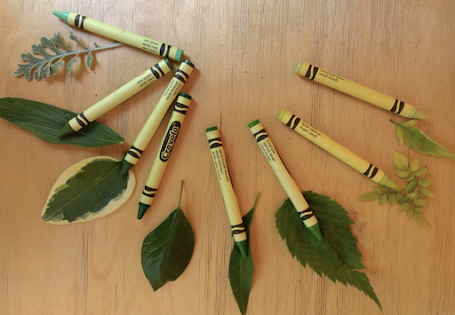It’s National Crayon Day this week on March 31st. As we get ready to celebrate, my friend and author of The Crayon Man, Natascha Biebow, wrote a special guest post for my blog today. It is filled with resources, projects and activities that we can all do with our students.
You can plan lots of activities to encourage students to explore color, nature, STEM and CREATE! Here’s how:
Edwin Binney, the inventor of Crayola crayons, was inspired by all the vibrant hues in Nature – he loved color! When you LOOK closely at the trees, leaves, flowers, bugs, rocks, dirt, and sky outside, you can see that Nature has some amazing colors.
Pick up a handful of crayons and go on a color nature hunt outside. (Or bring some nature inside or use objects around the classroom.) Encourage your students to look closely at things of the same color. How many greens can they find?
How many different tones of brown, blue, yellow, red and pink?
Encourage students to order the colors from darkest to lightest, or create a color wheel.
Now have fun making a nature collage or drawing a picture using as many different tones.
You can make leaf pictures like these ones.
Play the color story game! Imagine you only had the first 8 colors in the first Crayola crayon box invented in 1903. Challenge your students to work together imagine, draw and create a story, using each of the 8 colors only once:
“RED is going on an adventure. What will RED be and do?”
Next, do the same with BLUE, and then GREEN, YELLOW, ORANGE, PURPLE, BROWN and BLACK.
Encourage the students to use their imaginations – there are no right answers!
Here is an example.
Explore the science behind how Edwin Binney used natural materials to create safe, non-toxic Crayola crayons in the early 1900s. Here are some rocks and minerals that were used to make the pigments used to create bright crayon colors:
• red iron oxide (hematite) for red
• yellow iron oxide (goethite) for yellow
• varied shades of red iron oxide for brown
• carbon black for black
• zinc oxide for white
• and imported ultramarine made from lapis lazuli for blue.
To make orange, green, and violet, chemists blended various pigments and clays. Some minerals changed color when heated. Plus the length of time the mixtures were left to cool created different colors too. Today, new discoveries and technologies mean that different minerals and raw materials can be used to create some of these colors.
Go outside and LOOK closely at any rocks and minerals you can find. Or you can examine photographs of the ones that Binney used.
Ask students: What are their properties? Where did you find them?
Encourage students to record and draw their observations.
Ask students to look around the classroom. What other earthly treasures went into making the world around them? Is their use sustainable?
We asked Natascha, the author of The Crayon Man: The True Story of the Invention of Crayola Crayons some tricky questions:
What is your favorite food? Chocolate for sure. And I also love lasagna.
What is always in your bag? A book!
What is your favorite color? Periwinkle blue. What is yours?
Do you have any pets? Yes, I have a Jack Russell terrier called Luna. Walking her every morning is a great time to think about new stories.
How long did it take to write the book? 3 years! I wrote many drafts of the story and then re-wrote it some more after I did the research and fact-checked it.
What gave you the idea for this book? I watched an episode of Sesame Street where they showed the inside of the Crayola factory. I started doing detective work right away to find out more about who invented the crayons I loved as a child.
You can discover more about how Crayola crayons are made in this video.
What do you hope kids take away from the book? Edwin Binney had a knack for listening and making what people needed. He loved nature and it was the inspiration for the bright colors he wanted to create in the crayons. Still now, we are learning so much from nature! Binney was also a generous entrepreneur who gave back to his community. His flair for innovation, creativity, persistence and ability to listen are all attributes that future generations will need to make our world a better place. I hope young readers will be inspired to tap into their love of color and create something amazing! In this fast-paced world of ours, where kids are so often on devices, I’d love it if the book were to encourage kids to just doodle with crayons.
What is the coolest thing about being an author? I get to do something I love – write stories – and meet children all over the world.
The dual-layered text in The Crayon Man allows for students of different ages and abilities to access the main ideas in the story and dive deeper to discover further details, ideal for grades 2–5.
You can download the Educator’s Guide to The Crayon Man, which includes other fun cross-curricular activities.
If you’d like a virtual author visit for your school, get in touch!
Natascha Biebow’s favorite crayon color is periwinkle blue because it makes her heart sing. She loves to draw and make stuff, just like the inventor of the Crayola crayons. She lives in London, England, where she writes, edits, coaches and mentors children’s book authors and illustrators at Blue Elephant Storyshaping, and is the long-time Regional Advisor of SCBWI British Isles. In 2018, she was awarded an MBE for her services to children's writers and illustrators. www.nataschabiebow.com











No comments:
Post a Comment